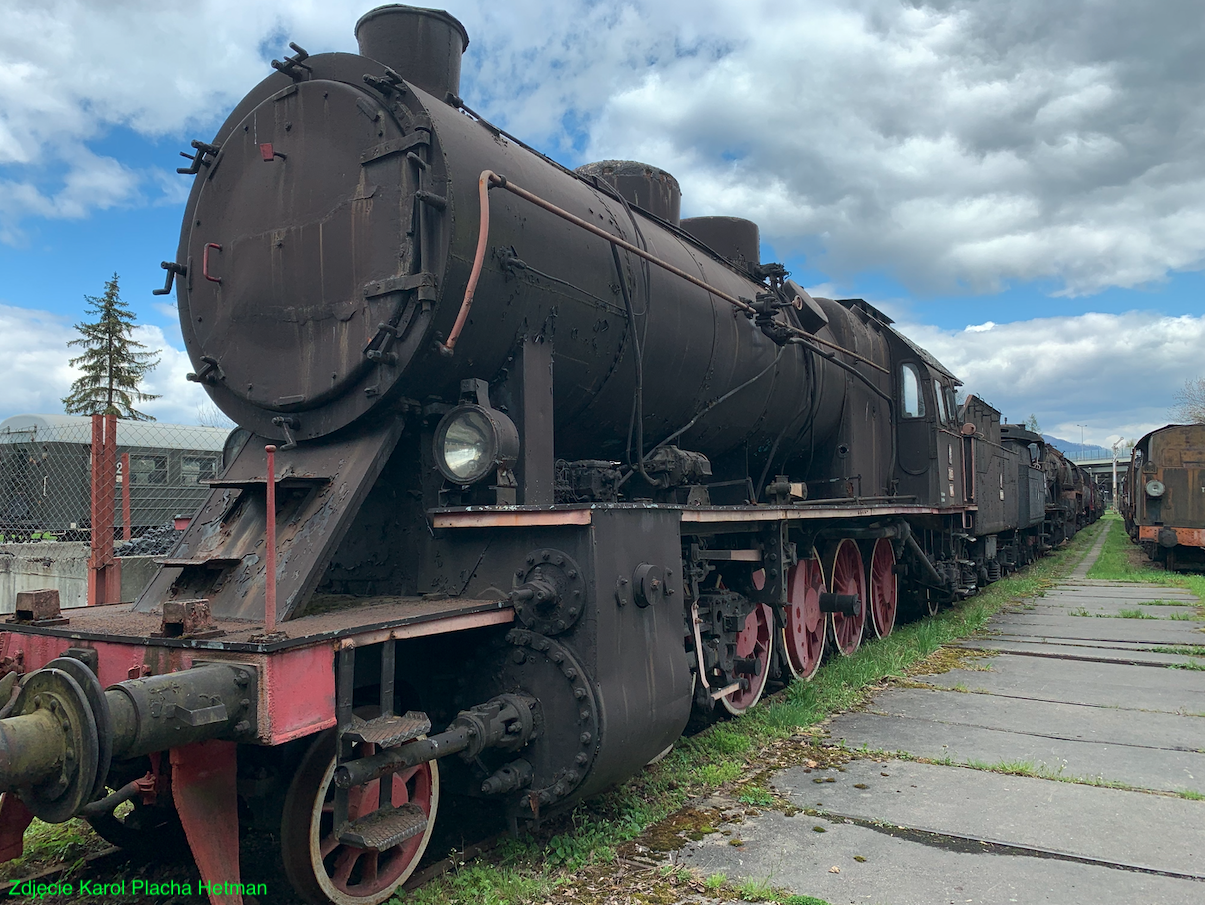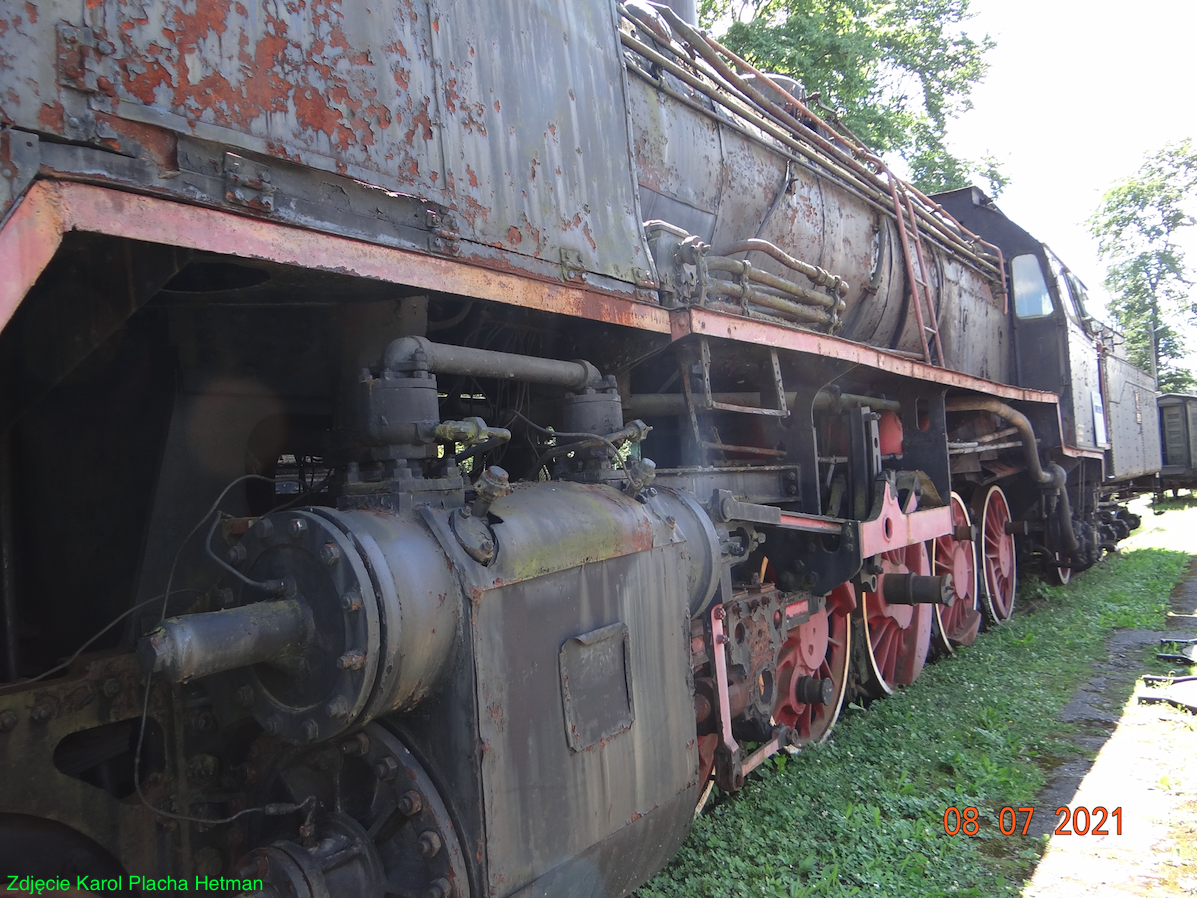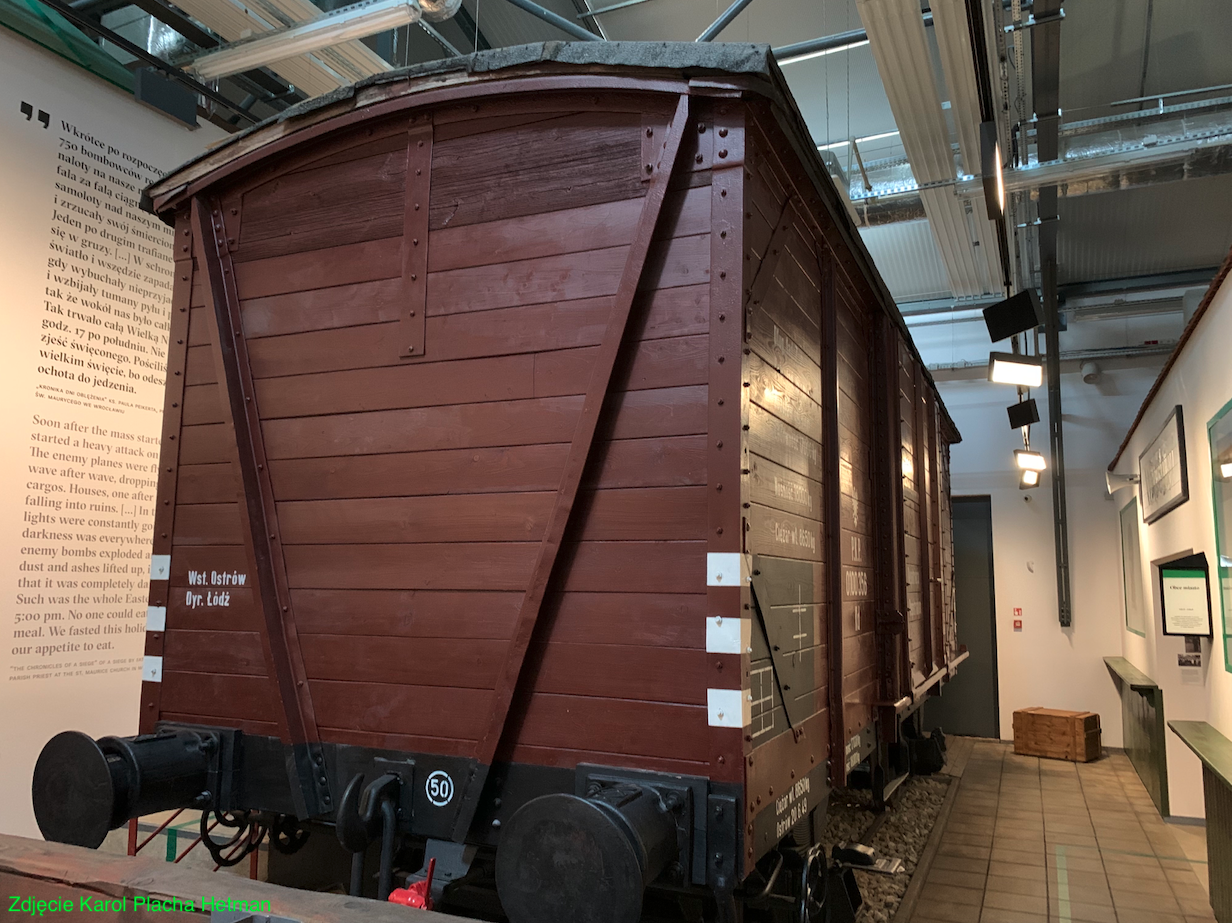Gdynia 2023-08-30
PKP Coal trunk line, section Nowa Wieś Wielka - Gdynia. 1930.
In other articles, we discussed sections of Węglówka: Kalety - Kępno and Nowe Herby - Inowrocław. We presented the history and reasons for the construction of Węglówka.

Photo description: The Ty23 series steam locomotive was a Polish heavy steam locomotive, which was developed by Polish engineers and produced in the period 1923 - 1934. Ty23 means a freight locomotive with the "y" axle arrangement, which was approved in 1923. The axis system is 1'E, i.e. 1-5-0 (oOOOOO), and the Polish designation is a small letter "y". Locomotives of this type worked during the Second Polish Republic on the No. 201 railway route, transporting hard coal from Polish Silesia to the seaport in Gdynia.


Railway line No. 201.
In order to bypass the already overloaded Bydgoszcz Główna junction, a bypass of Bydgoszcz was designed on the eastern side. The ring road starts from Nowa Wieś Wielka station and currently (2023) it is the beginning of railway line No. 201 to Gdynia station. The line No. 131 Chorzów Batory - Tczew also runs through the Nowa Wieś Wielka station. From the station there is a railway siding to the Fuel Base.
Among the forests, the Bydgoszcz bypass runs northwards. The trail reaches the Emilianowo station, which is a freight station. Then the trail passes under the viaduct of the National Road No. 10 "Circumferential highway". Then the trail enters the industrial area of Bydgoszcz, where there is a large network of industrial tracks.
Then the trail runs over a bridge over the Brda River. The bridge is a truss, three-span bridge, supported by two stone pillars. The trusses are made in the form of arches, and the track is placed on top. The effect is that the arches of the bridge limit the height of riverboats traveling down the river. Next to the railway bridge, a technical bridge was built on which pipelines were laid.
Then, the route crosses other railway lines and, in an arc towards the west, reaches the Bydgoszcz Wschód station, which was previously called Kapuściska Małe station, and in Prussian times (1861) Karisdororf and then Bromberg. At the Bydgoszcz East station, the following lines meet: No. 18 Kutno - Piła Główna, No. 209 Kowalewo Pomorskie and No. 201, which is our route. Railway workshops were built in Kapuściska Małe.
Then there is a freight station and another station Bydgoszcz Leśna. Then, at the junctions, the trail heads south to the Bydgoszcz Główna station or north to the Maksymilianowo station.
The section Maksymilianowo - Gdynia.
Existing sections were used in the construction; the section Kościerzyna - Somonino (25 km), built in 1901, which was part of the Kościerzyna - Kartuzy line, and the section Osowa - Gdynia (16 km), forming part of the local railway line Kokoszki - Osowa - Gdynia, built in 1921.
The legal basis for the construction of the current line No. 201 was the Act of the Sejm of June 1925. According to calculations made in 1930, the construction of a new line could bring profits of about 20 - 40 million zlotys a year.
The lines were commissioned in sections. In 1928, the section Bydgoszcz Wschód - Maksymilianowo and the section Bąk - Kościerzyna were handed over. In 1930, the section Nowa Wieś Wielka - Bydgoszcz Wschód, the section Maksymilianowo - Bąk and the section Kościerzyna - Gdynia were completed. On November 9, 1930, the Minister of Communications, engineer Alfons Kühn, officially opened the section Maksymilianowo - Gdynia with a length of 171 km. In December 1930, on the section Inowrocław - Gdynia, with a length of 234 km, the assembly of all railway traffic control devices and installations was completed.
The commissioning of the section Maksymilianowo - Bąk - Kościerzyna - Gdynia made Poland completely dependent on German railways and ports. This made the Germans very nervous. Southern European countries were also interested in coal, due to the possibility of export to Scandinavia. PKP provided transport services on time and at competitive prices. The bus turned out to be profitable from the very beginning of its use. Profits from operation showed a steady increase, constituting an important item in PKP's income.
On January 1, 1938, the Coal Main Line came under the management of the Franco-Polish Railway Society. But let's remember that in the period 1933 - 1938, PKP removed the shortcomings of the line and installed all railway traffic control devices, and the employees were already trained. The State Treasury participated in the income. According to the agreement, the concession was supposed to expire in 1975, but the German and Soviet attack in 1939 invalidated the agreement. It is estimated that the total cost of building the Coal Main Line amounted to approximately PLN 270 million.
Węglówka was built as a single-track line, but infrastructure; bridges, viaducts, culverts, railroad crossings, were prepared for the second track. Although as double track sections were made; Siemkowice (Chorzów Siemkowice) - Inowrocław, Kapuściska Małe (Bydgoszcz East) - Maksymilianowo, Osowa - Gdynia, the total length of the trail is 73 km. The Inowrocław - Bydgoszcz section, which was built before the Great World War, was also double-tracked.
Węglówka was built by Polish workers, according to the designs of Polish engineers. The Kościerzyna - Gdynia section was the most difficult from a technical point of view. All stations and passing points were made for 750 m long trains. Access posts were used to increase train traffic on the route. The bridge over the Brda River in Bydgoszcz was the most difficult to complete, due to the difficult, swampy terrain. The technical speed of the trains on this route was 45 km/h. But due to the stations and passing points, the travel speed was only 25 km/h.
For the section Bydgoszcz - Gdynia, a new design of the station was developed, which was called "Type Bydgoszcz - Gdynia". According to this project, 11 stations were built. In the design, the building has a usable area of 263 square meters, including 160 square meters of residential space. Most stations received hydrophores rather than water towers. Rectangular and stepped locomotive depots were also built instead of fan-shaped ones. A fan locomotive depot must have a turntable, and the size of the turntable determines the length of steam locomotives that can use the locomotive shed.
The Węglówka line ended at Gdynia station. Further, several sidings led to the station in the seaport. The construction of a modern Coal Main Line made it necessary to expand the railway station in the port. In the period 1927 – 1933, there was the greatest intensification of railway works in the Gdynia junction. In 1939, the total length of station tracks was 272 km. Gdynia Port station was able to accept 60 trains a day.
In the 1930s, two-axle coal cars with a capacity of 20 tons and four-axle coal cars with a capacity of 30 tons were used, which were called "American Type". In addition to typical coal trains, collective trains ran. Their compositions included: flat wagons, covered wagons, special wagons (for example, tank cars). They had a load capacity of 15-20 tons in two-axle wagons and 30-38 tons in four-axle wagons. The length of the trains did not exceed 750 m.
The trains were hauled by Polish Ty23 heavy locomotives, and at the end of the 30 years also by Polish Ty37 heavy locomotives. These second locomotives continuous trains weighing up to 2,000 tons.
The Second World War.
After losing the defensive war, the Germans incorporated the Polish territories into their borders. They created a general government for the liquidation of the Polish nation.
The Bydgoszcz - Bąk - Kościerzyna - Gdynia route was of no importance to the Germans. During the Second World War, route No. 201 was significantly damaged, and the Germans were preparing it for disassembly. The occupant mainly used the route Tczew - Pruszcz Gdański - Gdańsk. The Germans directed freight and military trains only to the double-track line Bydgoszcz - Tczew - Gdańsk. In 1942, a second track was built on the Sopot - Gdynia section. After World War II, it was not until 1949 that traffic was restored on line No. 201.
After World War II.
In the period 1965 - 1969, the entire coal main line Tarnowskie Góry - Herby Nowe - Inowrocław - Bydgoszcz - Tczew - Gdańsk - Gdynia was electrified. The section Maksymilianowo - Bąk - Kościerzyna - Gdynia was not electrified.
Railway line No. 201.
Detailed plans of railway routes were created in the years 1926-1928. Among them, the railway line No. 201, generally referred to as Bydgoszcz-Gdynia. The new main line was to follow a course as close to a straight line as possible. The route, due to modest funds, was to be single-track, with the prospect of adding a second track. This forced the construction of passing loops at regular intervals, regardless of the existing towns. This is how the stations among the forests were created. The line has become one of the most picturesque in Poland. It is located in the Kujawsko-Pomorskie and Pomorskie voivodeships. Geographically, it runs through the Pomeranian Lake District, Kashubian Lake District and Pobrzeże Gdańskie.
Already in 1925, a government regulation was ready under which it was possible to expropriate owners of real estate needed to build the railway. The railway route itself was built by a state-owned company, but the bridges and other infrastructure were built by private companies after winning tenders. Route No. 201 was put into use in stages. The first stage, around Bydgoszcz, was commissioned on May 15, 1928. It runs some distance from the Szwedowo airport. The second stage was the Czersk-Bąk-Kościerzyna section, which shortened the Tczew-Kościerzyna route, without having to drive to Chojnice. The Czersk-Bąk section runs a strange route, because the Poles used the Karsin-Bąk railway embankment, the Chojnice-Gdańsk line not built by the Germans, which would be an extension of the railway line No. 210 (Berlin-Królewiec).
On November 9, 1930, trail No. 201 was passable along its entire length. From the Gdynia station, the main line No. 201 transforms into the "Port Gdynia" railway siding. Until 1933, along the route No. 201, station buildings, water towers, hydrophores and coal handling equipment were built. In connection with the demands of the inhabitants, additional stations were built along the route, for example Babi Dół and Żukowo Wschodnie.
In the 30s, line No. 201 served mainly freight trains and express trains from Gdynia to Warsaw, Krakow, Lviv and Silesia. Most ordinary passenger trains ran from Tczew to Gdańsk.
After the Second World War, it was not until 1949 that traffic was restored on line No. 201. Route No. 201 was important because the Tczew-Gdańsk section was very overloaded with train traffic. Route No. 201 contributed to the development of local industry and towns: Kartuzy, Kościerzyna, Szlachta, Wierzchucin. From 1960, passenger traffic developed rapidly. Especially on the Kościerzyna-Gdynia section. There were plans to build a second track that were not implemented. In 1969, the Bydgoszcz-Tczew route (No. 727) and Tczew-Trójmiasto (No. 9) were electrified. Therefore, transit trains with electric locomotives were directed to this route.
On route No. 201, even in the 1970s, trains were mainly pulled by steam locomotives. In 1978, there were still 13 working steam locomotives in the Northern Directorate of PKP. The problem was that Poland had its own coal, and oil for diesel locomotives had to be imported.
In the 1980s, line No. 201 was constantly kept in full working order, but without major new investments. You can still find railway traffic control devices from 40 years on the trail. Second track construction or electrification was abandoned. The trains were operated by diesel locomotives.
After 1989, the transport of goods, especially hard coal, decreased significantly. Goods were transported on routes from Chojnice and Bydgoszcz to Gdynia. In 1990, the last scheduled fast train from Gdynia to Wrocław ran through Kościerzyna. Local passenger traffic gradually decreased. More and more people used buses and their own cars.
In 1991, the roundhouse in Kościerzyna was closed. It was the definitive end of steam locomotives, in track and maneuver traffic. From now on, steam locomotives are run only as retro trains and tourist attractions.
In 1992, the first railbuses of the SA 101 series appeared on the Kościerzyna-Gdynia route, and in 1994, the SA 102 two-unit. in the version with the possibility of heating passenger cars. A typical passenger train consisted of the SM-42 locomotive, a double-decker car (2nd class) and a passenger car (1st class).
W 2000 roku, zamknięty został dla ruchu pasażerskiego (osobowego) odcinek Nowa Wieś Wielka – Bydgoszcz Wschód, jednak latem jeździł tędy jeszcze wakacyjny pociąg Katowice – Słupsk.
In 2006, a holiday fast train Bory Tucholskie from Warszawa Wschodnia to Kołobrzeg was launched. This train passed through route No. 201, on the Maksymilianowo – Wierzchucin section, without stopping at any station. This connection was the longest route realized by PKP Intercity using diesel traction. Express trains ran along this route until 2016. The Bydgoszcz-Wierzchucin-Tuchola-Chojnice route is still served by passenger trains. Generally, route No. 201 was still used by passenger trains.
In 2010, Newag Nowy Sącz donated to the Pomeranian Voivodeship two two-unit diesel multiple units, type SA 137 (NEWAG 220 M) two-unit and SA 138 (NEWAG 221 M) three-unit trains. At that time, freight trains were mainly operated by SM-44 and SM-42 diesel locomotives.
In 2011, the revitalization of route No. 201 on the Kościerzyna-Gdynia section began, which was completed in 2015. The modernization included replacement of the surface, construction of new platforms and replacement of turnouts. As a result of the modernization, the speed was increased to 120 km/h; previously, the speed ranged from 60 km/h to 100 km/h. In the following years, the Maksymilianowo-Wierzchucin section was modernized.
In the period 2011-2018, passenger traffic on line No. 201 was minimal. The revival of passenger traffic took place in 2018, when poviat governments joined the cooperation. SA 133 (PESA 218 M) two-unit trains and SA 134 (PESA 218 M) three-unit trains were purchased. First as a pilot, for traffic in the summer season, and then all year round. Regular regional train traffic is run by Arriva RP, almost along the entire route, and by PKP SKM in Tri-City, up to Kościerzyna. The carrier operates SA 136 (PESA 219 M) three-car trains. Many trips are made by connecting two trains together. Long-distance passenger trains on route No. 201 appear occasionally.
Written by Karol Placha Hetman
